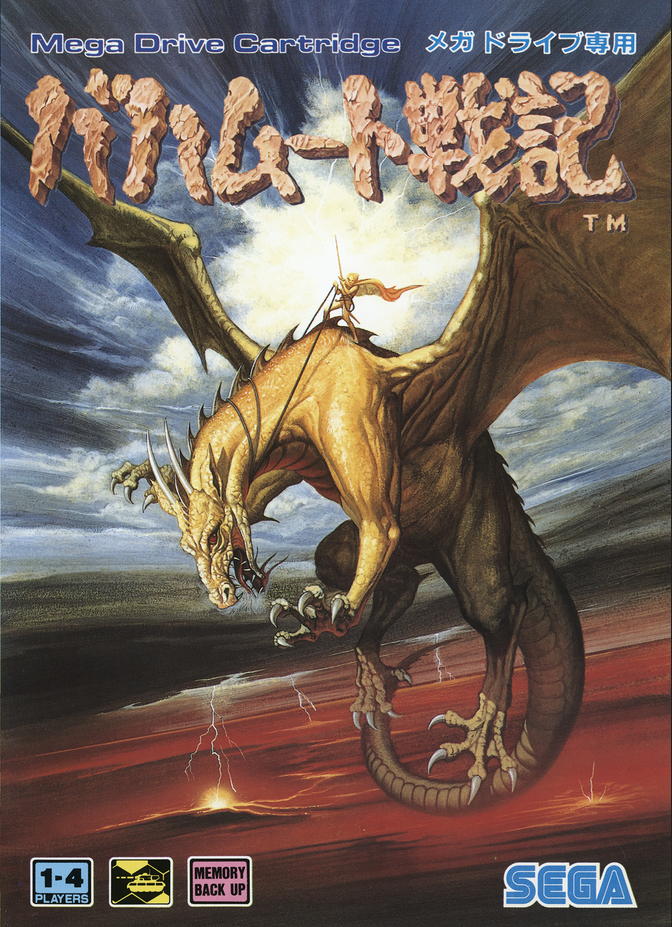
PUBLISHER/DEVELOPER: Sega
RELEASE DATE: 03/08/1991 (JP)
ALSO ON: Wii Virtual Console (04/24/07 – JP)
I’m still amazed that Herzog Zwei, the Technosoft-developed Genesis classic from 1989, was the first real-time-strategy game ever. Before Warcraft and before Dune II, Herzog Zwei combined elements of strategy and shoot-em-up into an anxious and hypnotic blend still unmatched today. And it was only on the Mega Drive/Genesis. Warrior of Rome is another RTS for the Genesis that predates the aforementioned PC strategy games. It’s considerably worse than Herzog Zwei, but both games’ presence on the Genesis signified that Sega’s console was ready to handle more than just arcade ports and shoot-em-ups.
Herzog Zwei and Warrior of Rome certainly broadened the Mega Drive’s horizons, but not even their presence prepared me for the behemoth that is Bahamut Senki. At a time where Koei had yet to lend its support to the Mega Drive, Bahamut Senki is borderline Koei-level strategy, sans the endless Chinese/Japanese warriors.
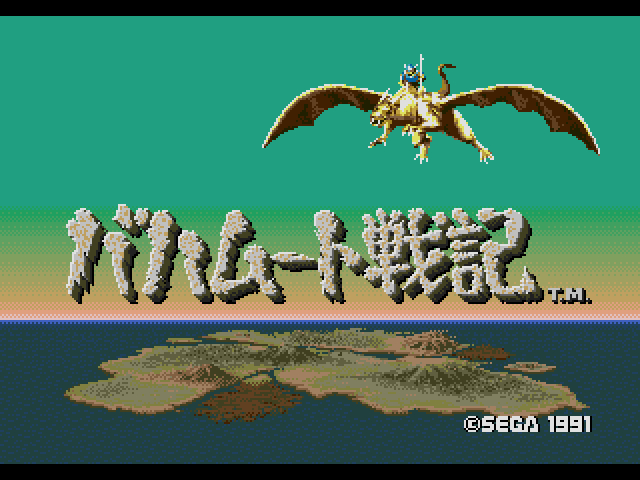
Bahamut Senki – or Record of the Bahamut War as the translators chose to name it – is a tale of eight strong master warriors all battling for control of the continent known as Bahamut. And this is a war, brother. You’ve got holy knights battling against demons, barbarians against elves, sorceresses against dragons, and Sir Balmer the undead (former) king of Bahamut against pretty much everyone. Pity the poor Bahamut citizens, just trying to grow crops or sell their wares. This is very much a bad time to be alive.
There are three sets of rules: Basic, Normal, and Advanced. With Basic, you are limited to the amount of commands you can use during different phases of the game, how you gather troops, and how you battle opponents – among other things. As you’d expect, Basic is great for beginners, while Normal and Advanced – both of which increase your range of commands, among other options – are for more skilled players.
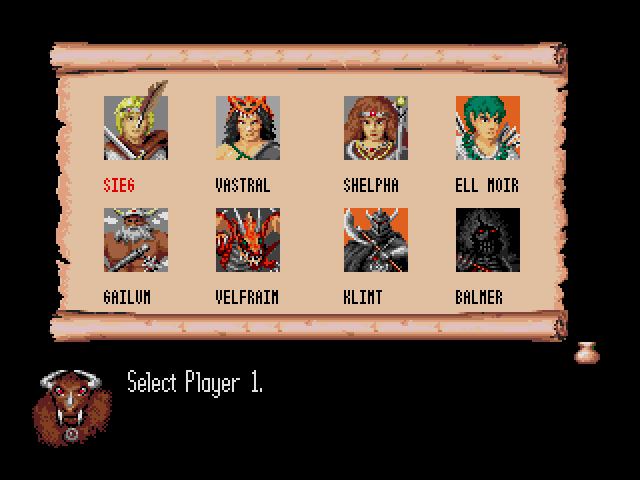
Once you’ve selected your rules, you choose one of four scenarios: “Holy Warriors vs. Berserkers” only has two master warriors battling for supremacy over all of Bahamut, and as a result, is the easiest scenario. “Requiem of the Age of Darkness” and “Order of the Chosen Dawn” add more master warriors, while “The Bloodthirsty Bahamut” includes all eight warriors, each of whom only have control of one area. If you’re looking to sink an entire day into Bahamut Senki, “The Bloodthirsty Bahamut” is the scenario for you.
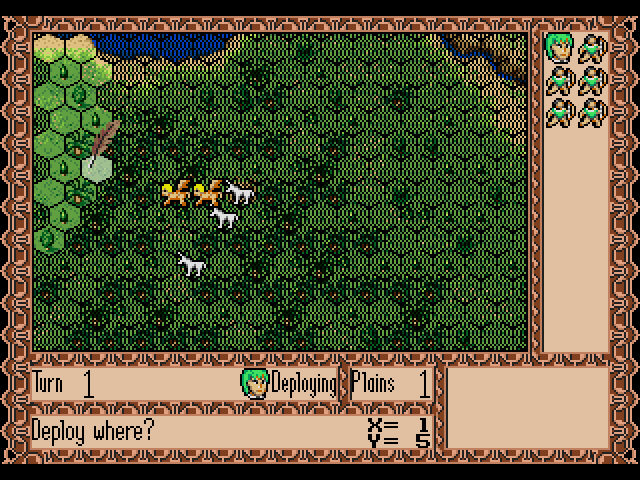
Up to four players can play Bahamut Senki. From what I understand based on the instruction manual, the first-player controller is passed around between all players. If you have a second-player controller, this is only used when your master warrior begins combat with another player-controlled master warrior. The one initiating the fight uses the first-player controller, and the one defending himself uses the second-player controller. This is neat, but given that each player is just passing the controller around (save for the real-time combat scenes, which I’ll explain later), couldn’t Bahamut Senki have been eight players? Perhaps I’m missing something. Also, for some reason, even if you’re playing a single-player game, the controller option on the Title Screen is automatically set to 2 Control Pads. Switch that sucker to 1 Control Pad or you’ll be in for some frustration later on.
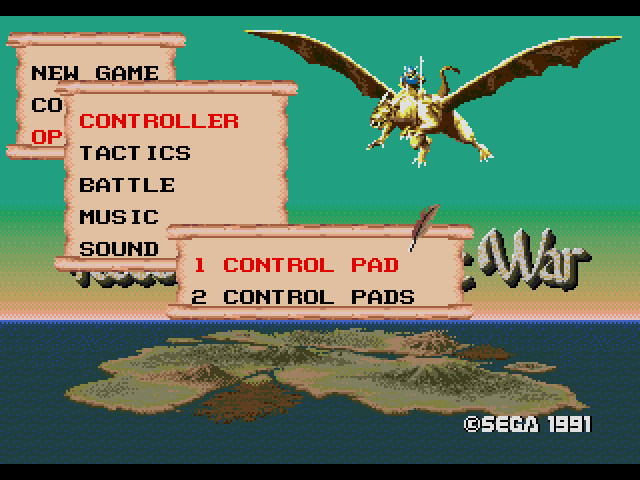
After you’ve chosen your rules, your scenario, the number of players, your master warrior, the game difficulty, and the settings, you’re finally ready to play Bahamut Senki….
Or so you think. If you jump into the game without at least browsing the instruction manual and character catalog, you’re in for a woeful amount of trial-and-error. This is no small task. The Japanese instruction manual is sixty-four pages, the Japanese character catalog is forty-eight pages, and the English-translated versions look at least that long, if not longer. I’m committed because I have to be, but if you’re only casually interested in Bahamut Senki‘s depths, now is the time to back out.
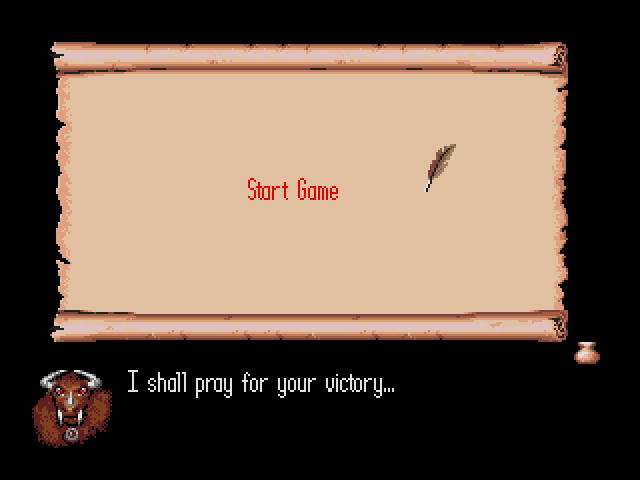
Let’s say you’re all in on Bahamut Senki, or all in for a playthrough or two at least. What can you expect? Because the game takes place on the continent of Bahamut only, there is only one map, although your starting position on the map depends on the scenario you’ve chosen.
You’re given a list of Policy commands at first, most of which have sub-commands in and of themselves. These commands – like Alliance (within Negotiate) and Delegate – are mostly diplomatic in nature. Hey, if you can avoid a skirmish while also taking advantage of your enemy (Alliance) or entrust sparsely monitored territories to the computer (Delegate), why not try? I’ve never been able to successfully negotiate an alliance with another master warrior. I imagine alliances are easier to obtain if one or two master warriors are occupying more territories than all the others. In those crucial moments, sometimes the enemy of your enemy is your friend.
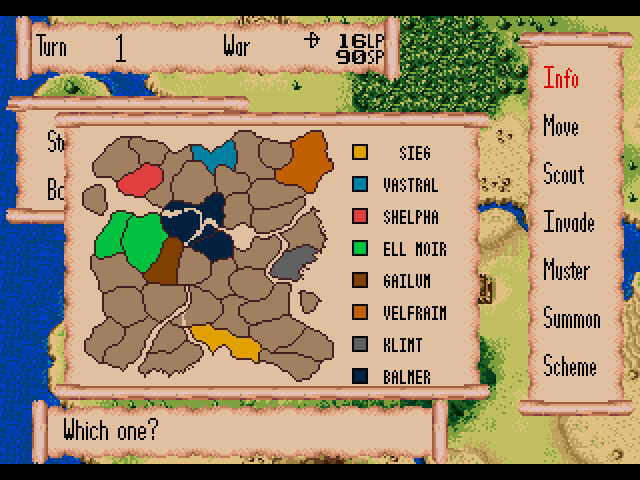
Once you’re done playing politics, the Policy phase ends and the War phase begins. The War phase is where you spend the bulk of your time in Bahamut Senki. Here, you can move squadrons, send scouts to see who occupies neighboring territories, invade said territories, summon monsters, and create additional squadrons under your command.
Let’s say you invade a territory. Once your squadron confronts the enemy, you either attack them in a simple screen (usually in Basic rules only, unless you change the option) or on a hex tile screen. The simple screen significantly limits your movement, while the hex tile screen gives your warriors more freedom and range. When your master warrior attacks an enemy in melee mode, the game switches to a top-down perspective and you’re able to fight your opponent directly, like you would in an action game. All other secondary warriors under your command only fight melee or use ranged weapons on the simple or hex tile screens. Once you defeat all the enemies, the territory is yours. The War phase ends either after you have used all your squadrons, or when you end it manually. The game then transitions to the other master warriors for their turns, until eventually coming back to you. The cycle then begins anew.
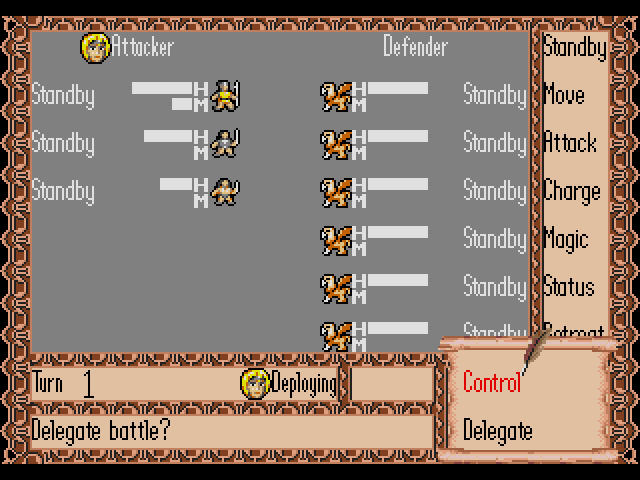
I’m a little over a thousand words into this review, and I’ve only lightly touched upon what Bahamut Senki has to offer. The game is dense, to say the least; I’ve yet to encounter another Mega Drive game that asks so much of its players. Those already used to the strategy genre probably won’t need much help sinking into Bahamut Senki. For those of you raised on arcade games, platformers, and the like, the game will feel incredibly daunting.
But as previously mentioned, Bahamut Senki offers beginners some options. This is a good thing, since I would consider myself a beginner – to the game certainly, if not the strategy genre as a whole. After perusing the manual and the character catalog, I played “Holy Warriors vs. Berserkers” (the easiest scenario) with the Basic rules (beginner rules) on Level 2 difficulty. The simple strategy screen was lame (this was my fault, I could have changed the screen to hex in the options), and a couple times I rushed into a battle that was too difficult for me. All in all, though, I had a reasonably enjoyable time with this scenario; like when you watch an ok movie, but you didn’t pay for it, so you don’t feel like your time was too wasted – that kind of enjoyment. Since several options from Normal and Advanced Rules were removed in this scenario, and the only other master warrior on the map was on the complete opposite end, I found myself invading and conquering territories, and mustering more squadrons with relative ease.
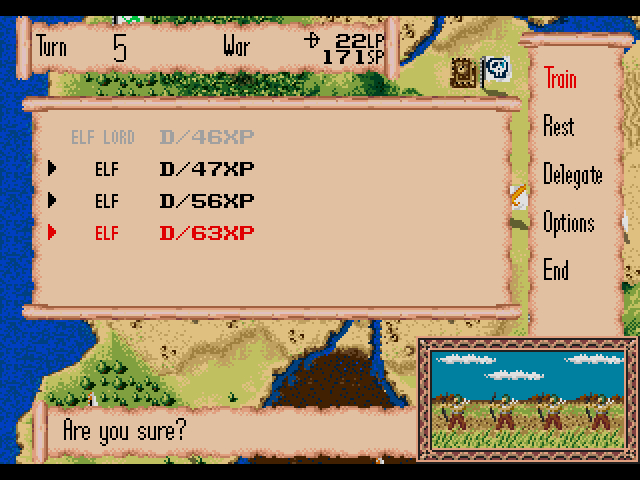
After my Holy Warriors triumphed against the Berserkers, I decided to dive into Bahamut’s murky depths and play “The Bloodthirsty Bahamut” (hardest scenario) with Normal rules on a Level 2 difficulty. Challenging, I assumed, but not impossible.
I didn’t get very far. Not because my elf warrior and his squadrons were wiped out (although we were certainly on our way out, thanks to some poor scouting on my part), but because navigating through the clunky menus became too much of a chore. I’m not sure what changed between my time with the easiest scenario and the hardest, other than adding slightly more options to the menu screen. Apparently, that was enough. Looking through Policy commands to find anything I could do was a waste of time. Moving troops, scouting locations, and even after you invade, moving every single troop into formation in order to attack: it’s all so time-consuming. I know you can delegate these tasks to the computer. Frankly, I don’t trust it to make the right decisions. I don’t particularly trust myself to make the right decisions either, but at least if I don’t, I can theoretically learn from my mistakes.
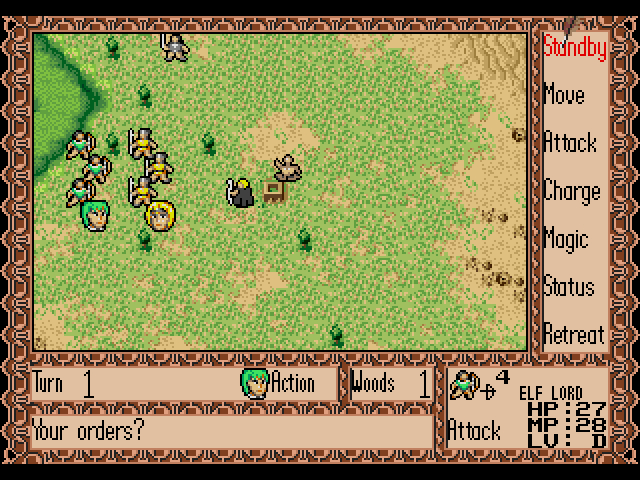
I acknowledge that this makes me sound like a big baby who can’t handle an antiquated interface. Strategy games aren’t generally fast-paced to begin with and this game is about three decades old, which likely adds to the slowness. I get that. But God bless the developers, I just don’t want to force myself to power through these cumbersome menus, turn after turn, in hopes that I’ll delude myself into thinking “It’s not so bad!”
After I wrote this last paragraph, I sat on the review. I didn’t know how to finish it. I wasn’t satisfied with how I played Bahamut Senki, but I also wasn’t thrilled about giving it another go. I’d already sunk hours into the game, and I didn’t know how much more of my time the game deserved. After a couple days of considering and pondering, I decided to suck it up and play one last game: Bloodthirsty Bahamut, Normal Rules, Level 2 difficulty. I forced myself to power through the cumbersome menus, turn after turn. Now, perhaps I’m delusional, but you know what? It’s not so bad!
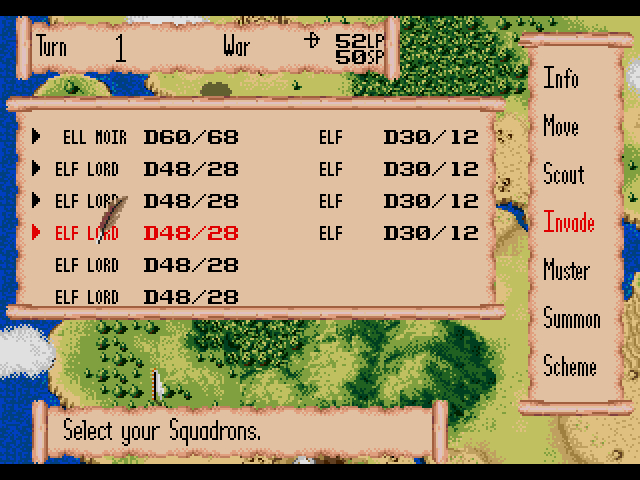
This go-through I made it a bit further than I did last time. I’ve already destroyed one master warrior and I’m on my way to decimating another (Gailum and Sieg, respectively), along with several territories. I’m not sure if I’ve made my peace with the menus (I still wish I could scroll through them faster), but we’ve developed a decent working relationship. I enjoy invading other territories far too much to let the menus get me down again.
As you may have inferred, Bahamut Senki is at its best when you’re going to war. Sending scouts to gain info about a territory, deciding whether to invade or not, invading, fighting, and winning against all odds, mustering more troops to take more territories: yes, it’s time-consuming, but it’s also incredibly satisfying. The Policy commands might prove worthwhile the deeper you get into the game, or perhaps when you’re playing with Advanced Rules. I like that Policy commands exist, I just wish the game would have allowed me to use them.
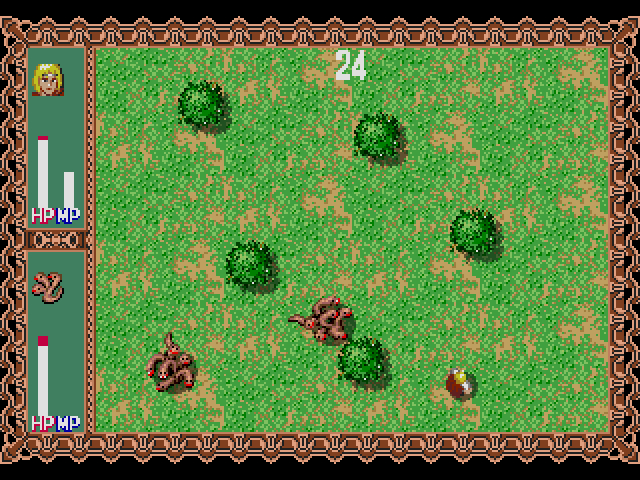
That Bahamut Senki and its supplemental materials are available to play/read in English is a miracle. What an undertaking! I can’t imagine the hundreds if not thousands of man hours put into this endeavor. Kudos and thank you to TheMajinZenki (translation), Supper (hacking), cccmar (editing and testing), filler (initial translation), Xanathis (testing), and Oddoai-sama (testing) for all of your hard work!
Bahamut Senki inspired a whirlwind of emotions in me: excitement, confusion, frustration, rage, satisfaction, and even elation at times. At first, I was indifferent to the game, then I was annoyed by it, then the game invaded its way into my heart through sheer will and determination. I couldn’t stop thinking about it, even when I wanted to turn my back on it and never play it again. For a game that I’m just playing to review, this sort of back-and-forth emotional roller coaster is unusual. For that, I applaud it. From its detailed backstory, to the in-depth mechanics, to the sheer amount of choices and options at your disposal, Bahamut Senki tests your patience and demands your respect. Not a classic, but still worth exploring.
B-

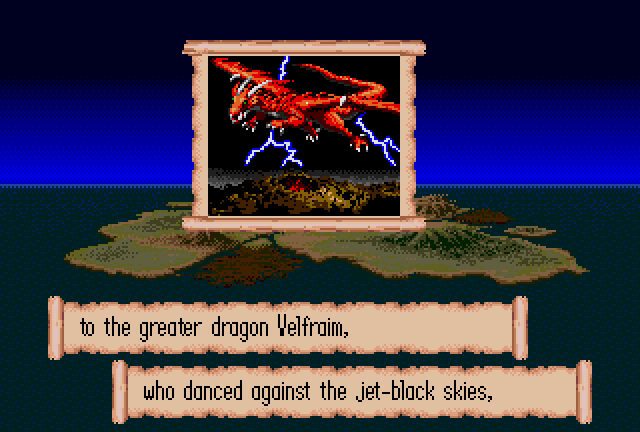
4 replies on “Bahamut Senki (Mega Drive, 1991)”
As usual a very cool, detailed review! You’ve summarized most of the features this game has to offer really well. It’s worth mentioning that this game’s true ending is 20 minutes long more or less (and really well hidden). If you end up getting to it at some point it’s certainly worth it. I am not sure if there’s a single Genesis game with an ending longer than this one, and it actually isn’t half-bad either. Overall, it was a fun project and a worthy addition to the MD catalog in English!
Thanks cccmar!
A 20-minute ending? That’s amazing. I hope Bahamut is able to rest after all this war.
Did you get the bug of stuck when enemy attacked your tuff? My game always hangs when enemy invade me…..I used to own the original cartridge when I still have my MD 30 years ago but now I can only play this on emulator and usually the game just hangs like that….You should do the demon lord and hack the heel out of every enemy on PK mode if you want quick wins. Demon lord and Magician have invincible spell which allow you to hack enemy without being hit, Magic missiles works too but not as good. Leech king is fun to play as it’s death army have many fun abilities. Of course heroes are always our favorite. Brute barbarians is very powerful slasher too.
I do believe you’ve put in more hours than I have or ever will. I commend you for that!